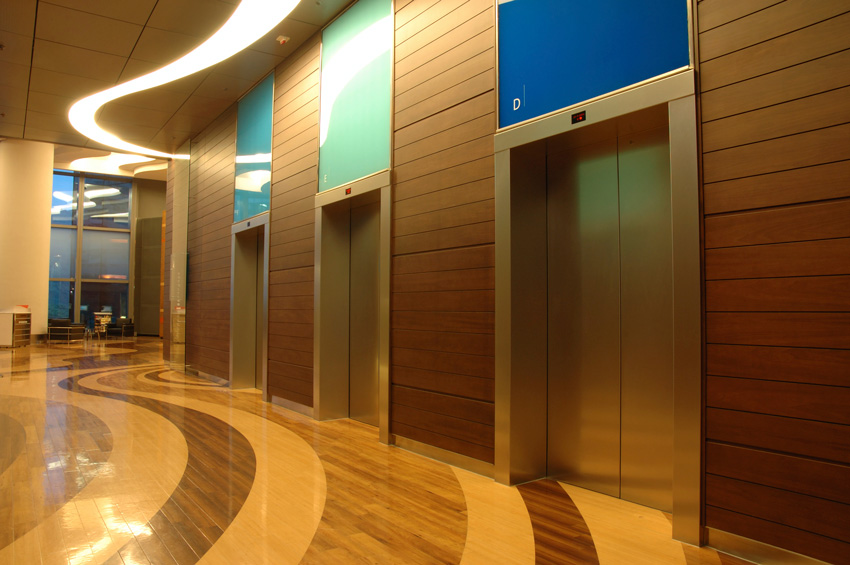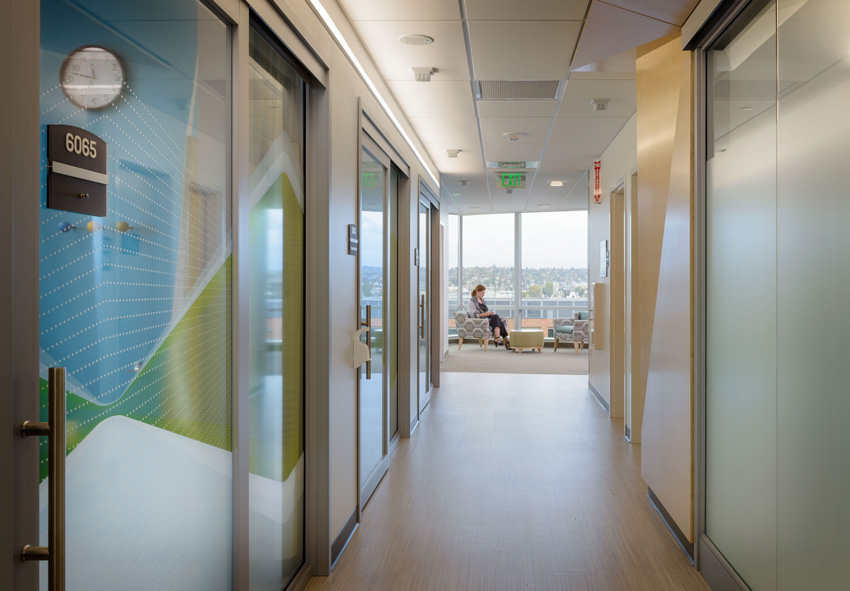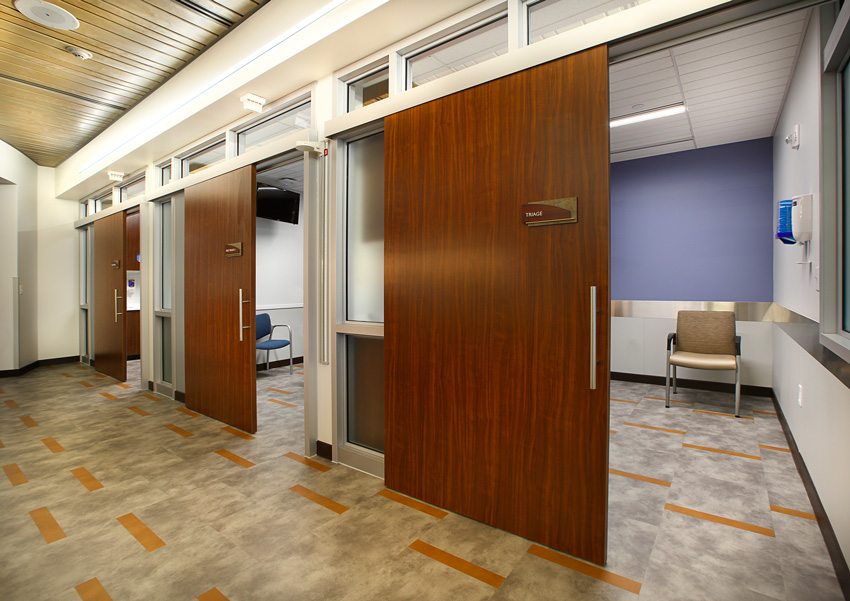Design Strategies for Optimal Well-Being in Health Care Environments
Improving the patient, visitor, and caregiver experience through innovative and flexible design solutions
![]() Continuing Education
Continuing Education
Use the following learning objectives to focus your study while reading this month’s Continuing Education article.
Learning Objectives - After reading this article, you will be able to:
- Identify architectural design features, such as sliding door systems, that can improve privacy and acoustics and explain how those systems add to a more positive patient experience.
- Discuss how specific paint and coatings technologies, as well as FRP systems, can improve building maintenance and life cycle while providing performance and functional attributes to benefit the overall well-being of occupants in health-care settings.
- Assess different strategies that can be used successfully to contribute to the design, construction, and operation of modern health-care facilities.
- Recognize various design elements used to create healthier, more productive, and more efficient health-care environments.
This past August, economists from the American Institute of Architects, the National Association of Home Builders, and the Associated Builders and Contractors got together to deliver a midyear status update on the health of the construction sector; the diagnosis was good. Spending through June 2016 increased by 2.2 percent over the same time period last year—$19.6 billion (2016) from $19.2 billion (2015). In a subsequent press release, AIA Chief Economist Kermit Baker, Hon. AIA, stated, “Given current demographic trends, the single-family residential and the institutional building sectors have the greatest potential for further expansion at present.” In 2017, growth is expected to swing to the institutional sector, with health-care construction spending poised to double.

Photo courtesy of The Sherwin-Williams Company
New strategies—from architectural design elements to bacteria-fighting solutions—are being used to create more productive and efficient health-care environments, and, importantly, to promote healing.
This all makes sense from a demographics standpoint. With the U.S. population gradually aging, there inevitably will be a greater demand for hospitals—not to mention the implementation of the Patient Protection and Affordable Care Act, which has resulted in millions more individuals gaining access to health-care insurance coverage, further driving up the need for hospital services.
With the demand for services and health-care construction on the rise, it is more critical than ever to create spaces that keep patients well and provide optimal environments for wellness, comfort, safety, and productivity.
As noted by The Center for Health Design, a 501(C)(3) organization, among the many concepts and strategies that might be considered include:
- Healthy building materials: Use products that are easy to maintain, are environmentally friendly, and don’t include toxins and carcinogens.
- Smart circulation: Include a central building spine that can easily be the backbone of future expansions, with separate public, patient, and service flows.
- Patient experience: Think about safety in transfers, bedside technology, and room standardization as well as positive distractions and elements like daylight. Infuse art into spaces where possible and integrate natural forms and materials, while also providing spaces for social interaction.
- Family space: Provide areas for family inside patient rooms and outside, with healing gardens available, too.1
The bottom line for everyone involved from patients, medical staff, and concerned friends and families to the project architects and designers is to promote wellness. That means taking a broader approach to the health-care environment. Addressing the patient’s physical health is no longer enough. We need to find new ways to promote overall health and well-being.
In the following course, we will look at some products and approaches that can contribute to achieving patient wellness, provider efficiency and overall occupant satisfaction in all types of health-care environments.
Effects of Noise in Medical Settings
In the words of Florence Nightingale, “Unnecessary noise is the cruelest absence of care.” Basic tenets of dignity and respect would dictate that a quiet and private space for recovery should be at the core of care in medical settings.
Noise is a factor that affects both patient satisfaction and outcomes as well as staff satisfaction and performance. In order to reduce hospital noise and improve the auditory environment, designers need to make a commitment to creating a complete healing environment for patients and staff.
With a greater focus on patient satisfaction and mandated standards, health-care facilities are seeking ways to increase acoustic comfort and privacy. These two factors strongly contribute to patient satisfaction by optimizing rest and relaxation as well as providing the peace of mind of confidentiality. By incorporating sound-masking strategies in health-care settings, patients are able to sleep better, resulting in an improvement of medical outcomes.
It is no secret that noise is a significant issue for many hospitals. It has been found that there are typically no fewer than 86 different sources, including patients, staff, and visitors talking; an abundance of sounds from televisions, alarms, carts, and doors; and the beeping and buzzing of medical equipment and mechanical systems.2
This cacophony is more than just a nuisance. More and more research shows that noise can actually cause physical harm to patients by elevating heart rate and blood pressure, for instance.3 Furthermore, noise obviously keeps patients from getting needed rest, which serves to weaken the immune system and can lead to problems exacerbated by lack of sleep, such as agitation, delirium, and decreased tolerance to pain.4
Moreover, adverse effects of noise go beyond just the patients. While it might seem that staff can just tune out the sounds they hear day in and day out, it’s just not true. No one can fully ignore these disturbances since human senses are designed to detect these types of changes in our environment. Noise disruptions, which impacts caregivers’ concentration, causes stress and fatigue, and potentially affects quality of care.3
The challenge of managing hospital noise and creating a quieter, more soothing, and relaxing environment is not just an abstract concept—its success is being measured against Hospital Consumer Assessment of Healthcare Providers and Systems (HCAHPS) scores and Health Insurance Portability and Accountability Act (HIPAA) compliance, and is tied to government funding in the United States. The resulting financial consequences can be substantial. HCAHPS surveys provide the basis for calculating Patient Satisfaction Scores under the Value-Based Purchasing (VBP) program, which enacts penalties on poorly performing hospitals by withholding Medicare payments. Currently, noise remains the lowest-rated marker of patient satisfaction across the United States.5 (For more details on the HCAHPS Survey, see the sidebar in the online portion of this course.)
How Sliding Door Systems Affect Acoustics, Privacy, Space, and Accessibility
Sliding exam doors provide a host of benefits for health-care settings. Some high-quality sliding door products are purpose built for outpatient health-care projects, providing a range of locking and latching, acoustic, and other functional solutions to suit the needs of medical office building (MOB)/outpatient/free-standing ER and patient restroom settings.
Successful door systems should be highly configurable and can be standalone doors or interior storefronts with sliding doors. Manufacturers should offer design support to ensure the sliding doors meet individual project requirements. Let’s look at some of the benefits and features of these door systems.Sliding doors vs. swing doors: The use of sliding doors can dramatically improve the efficient use of space in outpatient health-care settings or inpatient restrooms. A swing door requires that a significant amount of space be dedicated to the swing of the door and the approach clearances. Particularly in areas where large door openings are desired (typical of bathrooms or other areas in medical construction), the door swing is very obtrusive. When sliding doors are used, the layout of individual rooms is dramatically improved or a clinic can accommodate more exam rooms and usable space without wasting valuable space on door swings.
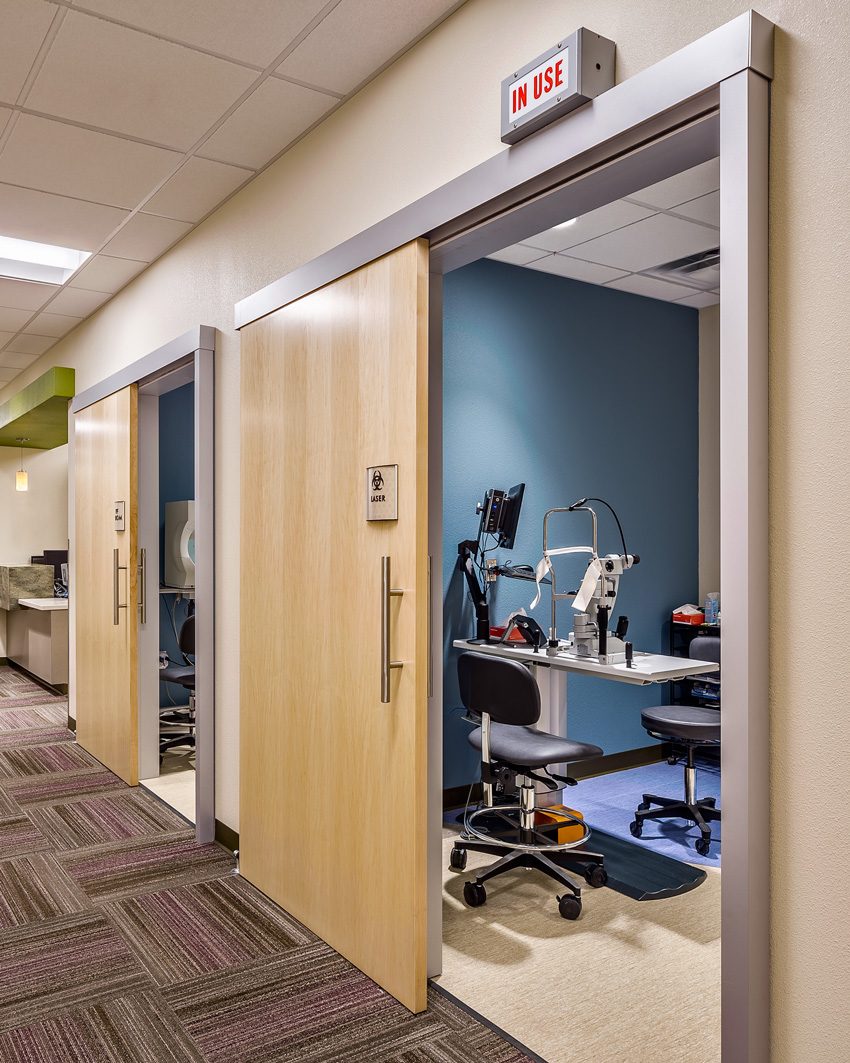
Photo courtesy of Dekker Perich Sabatini Architects
Sliding door systems can be used to improve the efficient use of space in many types of health-care settings.
Space and design considerations: Sliding doors can also be an excellent solution for achieving a unique design concept in patient room corridors. For instance, for the 18-clinic rollout of the MultiCare Indigo Urgent Care Clinics in the Seattle-Tacoma, Washington, area, the architectural design firm on the project, BCRA Design, at the suggestion of the GC, Anderson Construction, chose a sliding door system in order to meet its goal of avoiding uninspired corridor walls and instead create a dynamic focal point that was visible from the lobby and other areas of the clinic. Furthermore, the sliding door system achieves the fundamental principles of universal design, a feature BCRA considered when deciding on its door approach. Laura Jacobson, an architect with BCRA, explains, “In order to achieve this impactful look and still be compliant for a health-care setting, we needed a system with an integral relite that was still able to put the door plane flush with the wall to link branded signage elements from the door to the wall.” Additionally, the door system had the advantage of heavy-duty construction and STC-rated assemblies.

© Aaron Locke/BCRA
At the Indigo James Center, part of the MultiCare Indigo Urgent Care Clinics in Tacoma, Washington, a sliding door system helps to create an impactful design effect, while maintaining compliance for a health-care setting.
Maintaining acoustical and visual privacy: Acoustical privacy issues are often a concern with sliding doors in general, but some newer doors have been designed to achieve high levels of acoustical separation that are required in health-care spaces. Other standard features include a frame system that wraps the wall construction to prevent damage from high traffic in and out of spaces and closes gaps that present issues for visual and acoustical privacy, soft closers that prevent slams and wear and tear on the doors, and a top-hung assembly with a concealed bottom guide so that no exposed floor track is required, making it an especially optimal choice from an accessibility and cleaning standpoint.
Balancing acoustics and accessibility: According to Tysen Gannon, sales and marketing manager at AD Systems, a manufacturer of sliding door solutions, finding the proper balance of acoustics and accessibility can be a challenge. Gannon states, “The goal is to comply with FGI (FGI refers to the Facility Guidelines Institute, publisher of the Guidelines for Design and Construction of Hospitals and Outpatient Facilities) and ADA guidelines so that patients can expect speech privacy from a door with good perimeter seals and ideally a dropdown bottom seal but not have the door sealed so tightly that it won’t allow for ease of operation. It takes good design, engineering, and a lot of experience working on medical projects to make products that are up to the tough standards of those environments and the high expectations of medical facility managers.”
Installing an acoustical sliding door opens up the opportunity for health-care facilities and medical office spaces to realize a range of benefits. Developed to prevent a high level of sound from filtering through, acoustical sliding doors help these facility owners protect their work settings and provide patients and employees with a positive environment. The following advantages offered by acoustic doors make them an increasingly popular choice for numerous architects and their clients.
- Provides confidentiality: Patient confidentiality is a serious matter that is expected to be upheld in all doctor offices, medical clinics, and hospital institutions. Along with the Health Insurance Portability and Accountability Act (HIPAA) making it the responsibility of health-care providers to comply with strict regulations regarding privacy came a change in the way many establishments were designed and constructed. There have been many changes to facility design centered around addressing HIPAA concerns as well as more efficient delivery of care—and the use of sliding doors is of course affected by both. Along with designing full-height walls and being mindful of the routing of HVAC ducts, doors are a critical element of ensuring privacy of exam rooms, as they are responsible for sealing the hole in the wall that allows access. Sliding doors have traditionally been lower performing acoustically than swing doors because the tracks set them either within the wall cavity or part of the walls with spaces all around, but new sliding door designs feature much more solid construction than the typical “pocket door,” and acoustic gaskets and drop seal features bring their performance in line with the gasketed swing doors that would be used in the same occupancies.
- Helps maintain focus: Most medical offices are busy places, with constant action going on amongst coworkers and patients. In today’s on-stage/off-stage patient clinics, doctors and nurses are often working in open-plan environments in the “back-of-house” area. Frequently, the acoustical performance is only considered from the corridor side, but it is equally important for the provider side. This assures not only that patient confidentiality is maintained when doctors need to carry on conversations in the back of house, but also that workers in the open-plan environment are not distracted by what is happening in the surrounding exam rooms or adjacent areas. It can be easy to lose focus and difficult to concentrate on the tasks at hand when employees are consistently getting distracted and interrupted by everything that is happening around them so it is critically important that heath-care workers have workspaces conducive to concentration and productivity in order to deliver the best possible care to many patients.
- Offers a comfortable environment: Having the ability to get some peace and quiet when necessary does wonders for a patient’s recovery time and the happiness of employees. Nonstop noise is a general characteristic of medical establishments. This makes it hard for patients to get the rest and relaxation they need to get better in a timely manner. For staff, it cultivates a more stressful and overwhelming environment. To maximize comfort and eliminate disturbing sounds, an acoustical sliding door can be the answer.
Installing an acoustical sliding door will give health-care facilities all these noise-canceling benefits, while allowing them to maintain a high level of aesthetic appeal and save a significant amount of space as well. However, not all acoustic door systems are created equal so it’s essential to select products from a reliable supplier to ensure optimal performance. Look for a product comprised of high-quality materials, advanced engineering features, with numerous options for finishes and hardware, and that complies with ADA requirements. (See the sidebar on ADA Compliance in the online portion of this course.)
Keeping Bacteria at Bay
According to The Center for Health Design, “…easily transmittable diseases are a serious concern in most facilities today. Implementing some of the latest best practices in your physical environment can help to minimize their impact—and help you get the best outcomes from your efforts.”6 Some of the latest advancements include the advent of a microbicidal paint with the power to kill bacteria on a painted surface, as well as fiber-reinforced plastic (FRP) insulated metal panels that can create airtight seals.
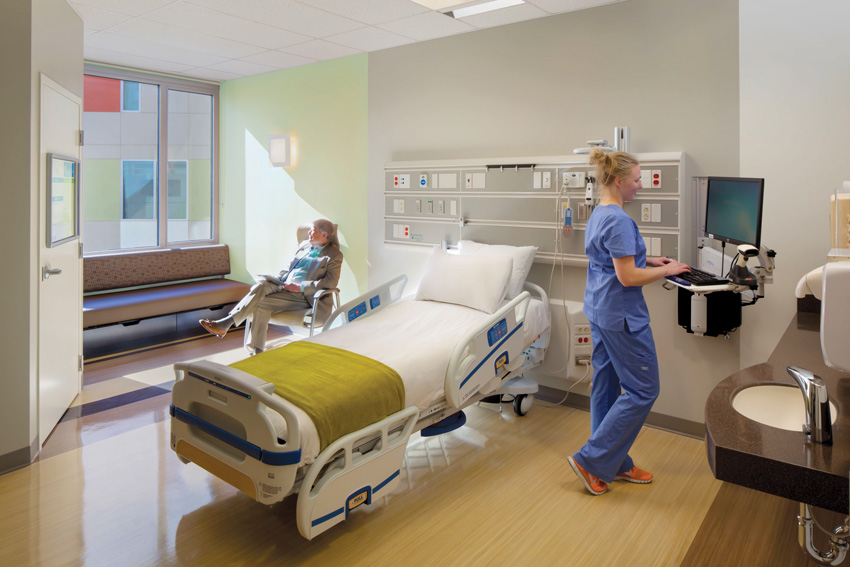
Photo courtesy of The Sherwin-Williams Company
Innovations in paints and coatings, including advancements in microbicidal technologies, can help support critical initiatives in medical settings.
Paints and Coatings
While it’s long been acknowledged that color choice can create a more restful environment, technological advancements in paint and coatings now let architects and specifiers deliver much more to a health-care environment than a soothing color. (More on color later in this course.) Innovations in certain coating technologies support critical initiatives in medical settings, including acute-care and long-term care facilities.
Improving indoor air quality (IAQ) and providing other unique benefits are among the key reasons to consider choosing an advanced coating to optimize the health-care facility setting. Some of the considerations include:
- Formaldehyde-reducing and odor-eliminating technologies help to improve the indoor environment of patient rooms in acute and long-term care facilities.
Hospitals and other facilities face many challenges when it comes to controlling odors, which can emanate from sources such as cafeterias, restrooms, and patient rooms. Odors can be detrimental for hospital patients, visitors, and staff members alike. Paint exists today with odor-eliminating technology that can deconstruct carbon molecules to neutralize and dissipate odors of an organic origin.
Airborne concentrations of formaldehydes and other aldehydes, known as volatile organic compounds (VOCs) that originate from sources such as carpet and insulation, contribute to poor indoor air quality. Paint with formaldehyde-reducing technology actually helps to improve indoor air quality by transforming aldehydes into water molecules and a harmless inert gas, resulting in a reduction in airborne concentrations of formaldehydes and other aldehydes. The length of time these technologies actively reduce odors and formaldehyde depends on the concentration, the frequency of exposure, and the amount of painted surface area.
- Antimicrobial technology can inhibit the growth of mold or mildew on the paint film in patient bathrooms, food service areas, exam rooms, and other areas where moisture is present.
Additionally, there are other benefits related to advancements in paint and coating technologies, particularly those with high-performance and microbicidal properties. Those benefits include the following:
- Microbicidal paint can offer health-care facilities an important new tool to help combat certain bacteria on painted surfaces. For example, one EPA-registered microbicidal paint can kill greater than 99.9 percent of certain bacteria* within 2 hours of exposure on a painted surface.
- High-performance coatings can be chemical and abrasion resistant.
According to Steve Revnew, senior vice president of product innovation at Sherwin-Williams, “For those involved in the decision-making process of selecting a coating for a health-care setting, it’s essential to be aware of new developments in coatings technology and their benefits in order to drive the most impactful outcomes in look and function.”
Paints and coatings go well beyond aesthetics. Advancements in technology mean paint now can accomplish a variety of important tasks ranging from killing harmful pathogens on painted surfaces, to helping reduce odors, to improving indoor air quality.
Revnew adds, “The advent of a microbicidal paint represents a major breakthrough in the industry, with far-reaching benefits for health-care facilities and beyond. This new paint has an active ingredient—quaternary ammonium compound (Alkyl Dimethyl Benzyl Ammonium Chloride)—commonly known in the health-care industry as ‘quat’ that actually kills five disease-causing bacteria. This advancement in technology means hospitals and other health-care facilities now have the ability to continuously kill harmful pathogens on painted surfaces with minimal effort.”
Fiber-Reinforced Plastic Insulated Metal Panels
Another industry solution being used to optimize hygiene and infection control in health-care settings requiring sterile environments are permanent fiber-reinforced plastic (FRP) insulated metal panels. FRP is a composite material made of a polymer matrix reinforced with fibers. The polymer is usually an epoxy, vinylester, or polyesterthermosetting plastic. FRP is commonly used in industries such as aerospace, automotive, marine, and construction.

Permanent fiber-reinforced plastic (FRP) insulated metal panels can provide an infection-control solution in sterile environments by preventing mold and mildew growth.
The panels are designed to create a virtually seamless joint between wall and ceiling to prevent mold and mildew growth. Generally speaking, the joint is where mildew or mold will grow the majority of the time, just like in your bathroom shower at home. While you can get mildew or mold on the walls, mildew or mold growth is more often found growing in the caulking at the joints. For health-care facilities where they may use chemical or high-pressure washes on the wall, the traditional surface-applied silicone or urethane sealants can weaken over time, thereby creating a place for mildew and mold to hide. The two-part welded seal used with permanent FRP insulated metal panels, on the other hand, creates a permanent bond, which does not break down over time with the use of harsh chemicals, frequent hot water, and high-pressure spray cleanings often required to effectively sanitize an area. A specialized caulk system bonds adjacent FRP surfaces together to form a smooth, reliable, long-lasting seal. This virtually maintenance-free system can be a perfect solution for commissaries, processing rooms, clean rooms, or pharmaceutical manufacturing facilities where frequent scrubdowns may be required.
According to Jay Smith, vice president of sales for Metl-Span, a manufacturer of metal roof, wall, and ceiling panel solutions, “The FRP wall and ceiling systems provide an easy-to-maintain and sanitize work station for health-care professionals, allowing them more time to focus on the things that matter.” He adds, “With a greater emphasis on building codes, fire rating standards, aesthetic conditions, and overall building expectations, architects and contractors are being asked to think more critically about wall systems and the specifications. Insulated metal panels, including FRP systems, provide a simple, all-in-one solution as well as an array of finishes and textures, which ultimately deliver functionality and appearance needed for today’s health-care buildings.”
FRP is manufactured and tested to be ideal for clean environments, such as those, as noted, which require a clean down, such as surgical rooms. Other applications include commercial kitchens, public restrooms, hospitals, schools, correctional facilities, restaurants, car washes, meat and dairy facilities, coolers and freezers, supermarkets, clean rooms, and laboratories.
Unlike traditional silicone, which requires maintenance every few years to remove and reseal the panels, with permanent FRP welded panels, the name says it all. Since it’s a permanent weld, it eliminates maintenance downtime. Featuring a lock-and-groove system, the double tongue-and-groove joint is exclusive to an insulated metal panel. This type of joint system provides the air and moisture barrier needed for the wall to protect the interior environment. The FRP panel’s joints are welded together, creating the signature smooth, permanent seal between panels and an area less likely to harbor bacteria, mold, or mildew.

Images courtesy of Metl-Span
Pictured are a profile image of an FRP insulated metal panel (left); a joint view of an FRP insulated metal panel featuring a lock-and-groove system (middle); and a top view of an FRP insulated metal panel (right).
Design and Performance
In an ideal situation, the design of a health-care facility should be one that exudes a feeling of welcoming, comfort, and compassion. Anyone who has ever endured a hospital stay, gone for myriad tests, or waited for a loved one to be attended to knows that the experience is much more positive when the surroundings relieve stress, not multiply it. The environment should be soothing, not jarring. You should be able to easily navigate the halls and have a comfortable place to stay. The facility also has an influence on the staff service attitudes and behaviors. According to an article by Robert Carr for the Whole Building Design Guide, a program of the National Institute of Building Sciences, “finishes, signage, and artwork must be carefully selected, well-coordinated, and integrated. Security can be balanced with some features apparent to patients/visitors, while conveying a message of safety. Thoughtful design can help ensure the proper first impression is created and sustained.”7
Carr adds that in the past, “communicable diseases were the major health problem, and sanitation or cleanliness was the main characteristic of a healing or therapeutic environment.”7 He asserts that while cleanliness remains crucial, increasingly there is recognition of the value of a pleasant, easily understood, and nonthreatening environment for patient recovery. Good design in the health-care setting, he says, “starts by recognizing the basic functional needs, but does not end there—it must also meet the emotional needs of those who use such facilities at times of uncertainty, dependency, and stress.”7
Color is one of the most useful design elements used to create a specific feeling within any setting, and is of particular importance in a health-care environment.
The Role Color Can Play
Color is a very powerful tool. Many researchers have concluded that the human eye can see roughly 10 million colors, while marketing research has indicated that 80 percent of visual information is based on color. Those numbers are astounding.8
In the recent report titled, “The Application of Color in Healthcare Settings,” published by The Center for Health Design (CHD), health-care design experts acknowledge the influence of color in a variety of health-care facility environments. According to the CHD, color selection in many different spaces—whether it’s light-filled open-air lobbies or the more subdued, neutral tones used in operating rooms—can result in optimizing the comfort level and outcome for patients and create a more advantageous setting for facility personnel.9
Conclusion
There are certainly countless ways to achieve the design, construction, and operation goals of health-care environments in a manner that brings about optimal health and comfort benefits to facility patients, visitors, and staff.
Understanding the options and some of the materials and systems currently available, such as those described in this course, can help architects, other design professionals, construction teams, facility managers, and administrators achieve these goals successfully.
Foot Notes
*Staph (Staphylococcus aureus), MRSA (Methicillin-resistant Staphylococcus aureus), E. coli (Escherichia coli), VRE (Vancomycin-resistant Enterococcus faecalis), and Enterobacter aerogenes
End Notes
12014 Healthcare Design & Expo. The Center for Health Design. Web. 9 November 2016. www.healthdesign.org.
2MacKenzie, D.J. and Galbrun, L. “Noise levels and noise sources in acute care hospital wards.” Building Services Engineering Research & Technology. SAGE Publications. May 2007. Vol. 28, No. 2.
3Joseph, A. and Ulrich, R. Sound Control for Improved Outcomes in Healthcare Settings. The Center for Health Design. January 2007. Web. 9 November 2016. www.healthdesign.org/sites/default/files/Sound%20Control.pdf.
4Xie, H.; Kang, J.; and Mills, G.H. “Clinical Review: The impact of noise on patients’ sleep and noise reduction strategies in intensive care.” National Center for Biotechnology Information. 9 March 2009.
5Moeller, Niklas. “Improving speech privacy and noise control for healthcare.” 20 January 2014. Web. 9 November 2016. Healthcare Facilities Today. TradePress. www.healthcarefacilitiestoday.com/posts/Improving-speech-privacy-and-noise-control-for-healthcare--3773.
6Infection Control. The Center for Health Design. Web. 9 November 2016. www.healthdesign.org/topics/infection-control?page=6.
7Carr, Robert F. “Health Care Facilities.” Whole Building Design Guide. National Institute of Building Sciences. 22 October 2014. Web. 9 November 2016. www.wbdg.org/design/health_care.php.
8Bamborough, Mary. “The use of color in healthcare settings.” Healthcare Design. 1 January 2011. Web. 9 November 2016. www.healthcaredesignmagazine.com/article/use-color-healthcare-settings.
9Bosch, Sheila J. et all. The Application of Color in Healthcare Settings. The Center for Health Design. October 2012. Web. 9 November 2016. www.healthdesign.org/sites/default/files/chd_color_paper_final-5_1.pdf.
Robyn M. Feller is a freelance writer and editor specializing in the architecture, design, and construction industry. www.linkedin.com/in/robynfeller

|

|

|

